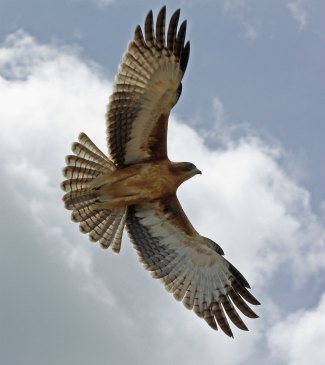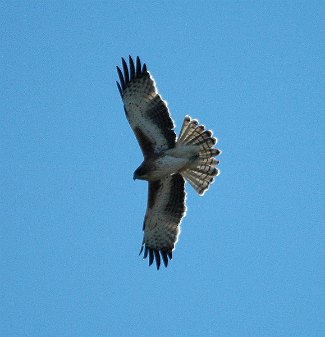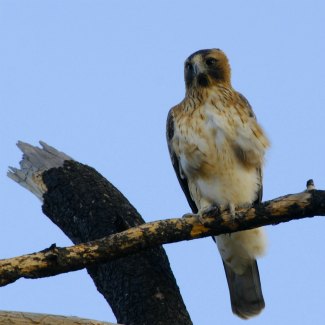Little Eagle - Aquila morphnoides
By Michael Jefferies, CC-BY-NC-2.0, via Flickr
Family: Accipitridae
Genus: Aquila
Species: A. morphnoides
Little Eagles are the world's smallest eagles. They have two morph forms and live in Australia and New Guinea in wooded habitat. They form a monophyletic group with Aquila ayresii (Ayres's Hawk Eagle) and A. pennata (Booted Eagle), and are a sister species to A. wahlbergi (Wahlberg's Eagle).
Physical Description:
There are two morph forms of Little Eagles: a pale morph and a dark morph, in addition to individual plumage variation. Pale morphs have brown upperparts, a red-brown head, light-colored underside, and black barring on the wingtips, along with a gray band across the wing coverts and scapular feathers. The less common dark morphs have dark brown upperparts and head and a light brown to brown underside. There is also a so-called, very rare "rufous morph" which is similar to the pale morph but has a rufous underside with black markings. Both the pale and dark morph forms have black streaking on the head and a shoulder band, barred tail, and slight crest. The eyes are yellow- to orange-brown and the cere is blue-white, as are the feet. The legs are feathered along the tibiotarsus, which is the part of the leg down to the bird's ankle; that is why Little Eagles are considered "true" or "booted" eagles.
Juveniles pale morphs are more rufous than adults, and dark morphs are darker in color with narrow barring on the chest. Eyes are dark brown.
A Little Eagle's call is a loud whistle repeated 2-3 times.
Size:
Length: 44-45 cm
Wingspan: 100-136 cm
Weight: 440-815 g
Habitat and Distribution:
They occupy wooded habitats including open forest, woodland, scrub, gallery forest, and savanna. They are most common in woodland along rough hilly country and they avoid dense forest. Their altitudinal range is from 0-1,500 meters above sea level in Australia, though they have been recorded as high as 2,100 m in New Guinea.
By Aviceda, CC-BY-SA-3.0, via Wikimedia Commons
They live in Australia and New Guinea, from 2°S to 29°S. Adults are irruptive or local migrants, but juveniles disperse from breeding areas and have been known to travel 3,000 km once they are no longer dependent on their parents. There are approximately 10,000-100,000 individuals across their range.
Diet and Hunting:
Little Eagles eat mammals, birds, reptiles, insects, fish, and carrion. Young rabbits are preferred prey in the south part of their range and birds in the north, and lizards are often caught in arid habitat. Fish are sometimes stolen from Haliastur sphenerus (Whistling Kite).
They hunt by gliding, still-hunting from a perch, or by soaring and quartering an area. They do not often take prey in flight. Despite being unable to carry a catch larger than 500 g, they will kill rabbits as heavy as 1.5 kg.
Reproduction:
Breeding displays consist of calling and near-vertical dives of around 50-60 m. The breeding season is from March-September in the north and August-October in the south.
The nest is made out of sticks and lined with green leaves and both parents contribute to the nest building. The nest can be up to 60-70 cm across and 30-60 cm deep and it is placed 5-45 m high in the fork of a tree, usually in open woodland or along a watercourse. 1-3, usually 2 eggs are laid and incubated by the female for 33-41 days. Fledging takes 54-56 days and the young are dependent on their parents for around two months after that.
Conservation:
Little Eagles are widespread and considered common throughout Australia, but their population is declining. Threats include habitat destruction, urban expansion, and poisoning from rabbit baiting. They are classified as Vulnerable in the Australian Capital Territory (ACT), are under review in Victoria, and Vulnerable status has been proposed in New South Wales. They are currently listed globally as Least Concern by BirdLife International.
By Pierre Pouliquin, CC-BY-NC-2.0, via Flickr
Taxonomy:
It was found based on DNA sequences of one mitochondrial and two nuclear genes that Aquila morphnoides, A. ayresii (Ayres's Hawk Eagle), and A. pennata (Booted Eagle) form a monophyletic group with A. wahlbergi (Wahlberg's Eagle) as a sister species.
All of the above species were formerly considered part of genus Hieraaetus, but many authorities now classify Hieraaetus as part of genus Aquila. Therefore, they are listed as Aquila on this website.
A. morphnoides is one of the remaining living relatives of Harpagornis moorei (Haast's Eagle), an extinct eagle species that lived on the South Island of New Zealand. In contrast to the Little Eagle's size, the Haast's Eagle was the largest eagle known to exist on Earth.
Subspecies:
A. weiskei (New Guinea Hawk Eagle) was formerly considered a subspecies of A. morphnoides, but evidence shows that it is more closely related to A. pennata (Booted Eagle). In addition, the DNA sequences between A. morphnoides and A. weiskei have just as much variation between them as other unchallenged eagle species.
Other Names:
Orel malý (Czech), Australsk Dværgørn (Danish), Australiche Dwergarend (Dutch), Australianpikkukotka (Finnish), Aigle nain (French), Kaninchendler (German), Elang Kecil (Indonesian), Aquila minore australiana (Italian), Småørn (Norwegian), Águila Australiana (Spanish), Pygméörn (Swedish).
Other Multimedia:
References:
http://www.avianweb.com/littleeagles.html
http://avibase.bsc-eoc.org/species.jsp?avibaseid=1117758C10E72439
BirdLife International (2012) Species factsheet: Hieraaetus morphnoides. Downloaded from http://www.birdlife.org on
05/01/2012.
http://birdsinbackyards.net/species/Hieraaetus-morphnoides
Global Raptor Information Network. 2012. Species account: Little Eagle Aquila morphnoides. Downloaded from
http://www.globalraptors.org on 5 Jan. 2012
BirdLife International 2009. Hieraaetus morphnoides. In: IUCN 2011. IUCN Red List of Threatened Species. Version 2011.2.
www.iucnredlist.org. Downloaded on05 January 2012.
Ferguson-Lees, James, and Christie, David A. Raptors of the World. Houghton Mifflin Company, 2001.
http://www.raptor.org.au/amorphnoides.html
http://www.threatenedspecies.environment.nsw.gov.au/tsprofile/profile.aspx?id=20131


